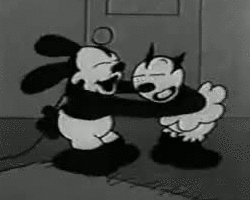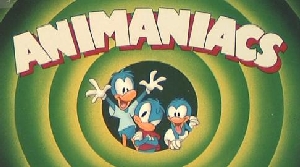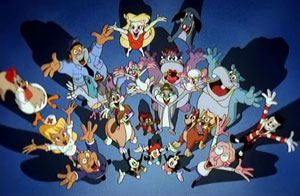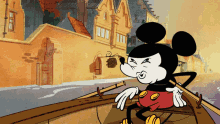The Great Retro-Animation Escape-Premise Controversy (1993)
Post from Animation Nation Netlog, by Mary Mel O’Dea, May 5th, 2013
The early 1990s saw a new Golden Age of TV animation. It was originally driven by Disney in the late 1980s with Warner Brothers right behind and Triad and Hollywood Animation (a.k.a. DiC) quickly making their mark. So, when Disney announced their latest animated TV series
Out of the Vault! in partnership with Amblin, few people paid much attention.
At least until Warner Brothers cried foul.
Out of the Vault! is a classic of the ‘80s/’90s animation renaissance. The official Disney story, which I have no evidence to refute, begins with Steven Spielberg approaching Roy Disney and Jim Henson in the early 1990s with an idea: a truly retro cartoon that harkened back to the days of “Steamboat Willie”. In his idea they would reintroduce the precocious Mickey from the Walt-and-Ub pre-Hyperion era: a clever, tricky little scamp who always got into trouble and used his wits – and some violations of the laws of physics – to win the day against insurmountable odds.
“My kids think Mickey and Minnie are boring,” he reportedly told Roy. Certainly, Mickey had come a long way since “Steamboat Willie”. Over the decades he’d arguably matured and mellowed, losing his trickster edge and becoming an “aw, shucks” everyman. Minnie had gone there with him. And while
Mickey in the City and other recent TV animation had given him back some personality (he was “on the verge of becoming a stale corporate mascot before we got to him” claimed Frank Oz), Spielberg had a real soft spot for the clever and chaotic cartoons of his childhood. He wanted a show featuring a return to Mickey’s absurdist, anarchic roots. He wanted Him and other retro-characters to emerge again in the modern day, sewing chaos and madcap in a postmodern, absurdist satire full of self-aware jokes and fourth wall breaks.
Disney and Henson agreed on the joy of the old cartoons, but Roy in particular felt that Mickey had “moved on” and Henson agreed that a reversion at this point would likely not play well with a generation that had grown up on “the friendly neighborhood mouse”.
“What if we call him Mortimer?” asked Roy.
Brother Mortimer (Image source “netclipart.com”)
When Walt and Ub first created a cartoon mouse to replace
Oswald the Lucky Rabbit, which had been claimed by Universal along with most of Disney’s best animators in the late 1920s, Walt wanted to name him Mortimer. His wife Lillian convinced him to go with the friendlier name Mickey. In Roy’s opinion they could “reintroduce” Mickey’s “long-lost older brother Mortimer” as exactly the kind of anarchic old school cartoon that Spielberg wanted.
Mortimer may have been on his mind because of a recent controversy surrounding
Outland, a newspaper cartoon strip by
Bloom County creator Berkley Breathed. The strip introduced a character named Mortimer Mouse, a tough, jaded, cigarette-smoking satire of Mickey and by extension Disney and corporate children’s entertainment. Like in the proposed new animated series, Mortimer from
Outland was Mickey’s estranged older brother. But in Breathed’s telling, the breakup was far from amicable.
Outland’s Mortimer Mouse in our timeline’s response to Disney’s lawsuit (Image source “disneynouns.files.wordpress.com”)
They’d sent Breathed a “polite, but strongly worded letter” in 1989 to cease and desist and eventually settled out of court. Mortimer vanished from
Outland without a word[1] and Fantasia TV later produced TV specials based on Breathed’s new children’s books
A Wish for Wings That Work: An Opus Christmas Story and
The Last Basselope.
And thus, Mortimer would return to Disney in a far friendlier form than Breathed’s jaded version, but Mortimer alone wasn’t going to hold the show together. They kicked around some ideas for some sidekicks and co-conspirators, deciding that a trio would work best. Roy at one point lamented the loss of Oswald and his feline girlfriend Ortensia to Universal, recalling how much his uncle Walt always felt anger about that “betrayal”.
Universal hadn’t been using the Oswald IP in decades and reportedly had no intention of starting now.
Spielberg said, “I’ve got some friends at Universal; I’ll see what I can do.”
Sure enough, Steven Spielberg managed to negotiate the sale of Oswald and the rest of that cartoon’s cast to Disney in 1991 for an undisclosed amount rumored to be in the low millions, along with negotiating some minor grievances that had emerged over theme park rights given Amblin’s cooperation with both companies in that area.
Oswald and Ortensia then and now (Image source “aminoapps.com” & “disney.fandom.com”)
So, they now had their three leads and a few supporting characters, but how to introduce, or reintroduce, the characters to the modern day? The solution “was obvious” in the words of the creative team: the legendary “Disney Vault”. The three characters of Mortimer, Oswald, and Ortensia would “escape” from the Disney Vault and cause chaos in a show guaranteed to appeal to younger audiences thanks to the physical humor and absurdist jokes and appeal to adults thanks to some satirical elements and cagey adult humor.
The show became
Out of the Vault!, the name inspired in part by the old
Out of the Inkwell Fleisher cartoons and in part by the (in)famous Disney Vault, and it was a breakout hit when it debuted as part of the NBC Jr. block in 1993. Mortimer became the leader, a tricky but fun-loving and happy-go-lucky type who just wanted to make his way in peace in a cruel world, but he had a very defined sense of right and wrong and took chaotic vengeance on any ne’er do well that challenged or threatened him, his friends, or any innocents. Oswald was a lazy, entitled, and slightly hedonistic but charismatic schemer in a “silly Han Solo” sort of way, who is inevitably up to some get-rich-quick scheme or developing overcomplex ways to avoid even the smallest amount of hard work. Ortensia is a “cute” and comedically melodramatic girly type on the surface, but this hides a whip-smart and industrious side that inevitably saves the day while the “boys” look on, amazed once again. She’s also often the source of some more complex sociopolitical satire for the parents. All three have absolutely no respect for the fourth wall or laws of physics. Mortimer, Oswald, and Ortensia (or “MOO” as the running gag went) became hugely popular with kids and adults alike with their chaotic, Vaudeville-inspired humor. Celebrities, other Disney characters, and even the Disney & Amblin execs themselves were open to abuse at the hands and words of the “MOO Crew”[2]. Nonstop gags, lampshade-hangs, fourth wall breaks, and absurdist elements prevailed, as did some adult humor (“I love that thing that you do with your tail”).
The MOO Crew would bring chaos wherever they went and even the laws of physics couldn’t constrain them. Ortensia in particular commonly detached her own tail to use as a club, hook, pry bar, or other tool (a gag “borrowed” from classic Felix the Cat shorts, and indeed the success of
Out of the Vault would spur Don Oriolo to partner with Hollywood Animation/DiC to debut
The Mad, Mad World of Felix the Cat on ABC in 1995[3], where Felix would ironically be accused of “copying” Ortensia by viewers). Tails in general were a regular source of humor. In one famous scene from the first episode, a newly escaped Mortimer asks his younger brother Mickey “Oh, my, what happened to your tail, brother?!”
Almost no jokes were completely off limits, but some were. A background appearance of a cryogenic chamber in the Disney Vault was nixed by Roy. A joke about Al Sharpton not allowing them to reintroduce
all of their old friends in the vault was dead on arrival, but became a favorite behind the scenes anecdote. Still, it was impressive how many things slipped past the internal and external censors alike, particularly the hyper-protective Roy, who reportedly had apoplexy when one of the more infamous tail jokes was explained to him after the fact (“You’ll need to work your tail harder than that if you want that money, my dear,” as said by Oswald while Ortensia struggles to lever open a pirate’s treasure chest with her tail).
Warner Brothers Animation, however, was
not laughing. The entire concept was a little
too similar to the plot of their own
Animaniacs, released the same year on the PFN Kids block, which featured, among other characters, three wise-talking Marx Brothers inspired Platypus[4] brothers named “The Warner Brothers” who escaped from their years of imprisonment inside the Warner Brothers water tower.
The
original idea for the Warner Brothers: three Platypuses…err… Platypi…err… Platypae…platy… um…two more than one Platypus!
The origins of
Animaniacs began when Warner Bros. Animation head Jean MacCurdy tasked director Tom Ruegger with producing a new animated show. Inspired, he says, by the iconic WB Water Tower, he imagined a scenario where three wacky old school cartoon characters “of the Tex Avery kind” escaped from imprisonment in the tower into the modern-day world. Jean loved the idea and gave it her full support. For the three “Warner Brothers”, who were inspired by his own precocious sons, Tom resurrected his original art school animation: Platypus Duck. Lucky, Plucky, and Duckie, the Warner Brothers, were born.
Lucky, the oldest, was a Groucho-like leader with a razor-sharp mind. Plucky was a natural schemer in the Chico mold. Duckie was the youngest, a silent, prop-oriented toddler in the Harpo vein who “spoke” through gestures, charades, and a bike horn or other noisemakers. Much like with
Out of the Vault!, the Warner Brothers would escape and wreak havoc in the world using cartoon physics and child logic, though they were clearly more inspired by the 1940s-era Looney Tunes and Tex Avery shorts than by the 1920s-era black & white classics that inspired the MOO Crew. Like with
Out of the Vault, celebrities were fair game and frequent targets, though the recurring WB Chairman was left unnamed and only subtly based on Chairman/CEO Richard Daly. And if
Out of the Vault pushed the limits on the adult humor, then
Animaniacs decimated them, such as with the recurring character/running gag of Hello Nurse and the infamous “
Fingerprints” joke.
The similarities to
Out of the Vault were obvious to everyone and not-so-subtle accusations of plagiarism flew in both directions, with MacCurdy and Spielberg in particular each suggesting that the other must have somehow overheard
their original plans during one of Spielberg’s visits to Warner Brothers. Others suggested a “leak” by a disgruntled employee on one side or the other. The superficial resemblance between Lucky, Plucky, & Duckie and Huey, Dewey, & Louie also didn’t go unnoticed. Fans of both shows came to similar conclusions, despite a lack of supporting evidence either way and with both sides sticking to their original stories. An inevitable rivalry was born.
Featuring some, but not all of these, plus others not from our timeline…
But the Warner Brothers were not alone in
Animaniacs, joined from the beginning by other now-iconic characters: Pinkie and the Brain, two lab mice inspired by animators Eddie Fitzgerald and Tom Minton who try (and fail) to take over the world. Slappy Squirrel, a cartoon character from the classic age who’s now a grumpy old woman, reportedly inspired by a conversation between writer John McCann and animator Sheri Stoner about the latter’s long career of playing troubled teens, a role that she’d allegedly still be playing “when she was 50”. The sexy but innocent Minerva Mink, who pushed the censors to the brink. The Bird Brains, three would-be superhero pigeons based on exaggerated but affectionate versions of Brad Bird, Bruce Timm, and Paul Dini, who try to fight crime dressed as obvious parody versions of Superman, Batman, and The Flash (the Bird Brain animators loved it, and guest-drew an episode for Season 2). The Wise Acres, three mafia-like donkeys who want to “corner the grain racket” on an upstate New York farm and who were clearly based on the Pesci, De Niro, and Liotta characters from Scorsese’s
Wise Guys. Mandy and Buttons, a danger-magnet toddler and the put-upon dog who tries to protect her. The yuppie-like Hip Hippos. The rageaholic Katie Kablooie. Kiev the Communist Chicken, who keeps trying to organize a “worker’s revolt” in the henhouse. And in the end, while Lucky, Plucky, and Duckie would be the lead characters and Slappy and the Bird Brains would have a strong following, it was Pinkie and the Brain who became the true breakout sensation, eventually gaining their own spinoff.
And indeed, it was these other characters that gave
Animaniacs its distinct feel from
Out of the Vault and helped defray the controversy of the similarities. While some segments of the fandoms remained angry and accusatory, the animators and producers themselves harbored no grudges. In the end, the accusations never went beyond playful barbs in the respective animated shows (“I have a wholly original idea for a cartoon: I call it ‘Out of the Water Tower.’”; “What’s next, cats & rabbits in a romantic relationship?”; “What, you’d prefer I was a platypus?”; “Any resemblance to another show you’d care to mention is strictly intentional on their part.”). Behind the scenes, however, the animators loved each other’s work and frequently met for volleyball games, picnics, and other inter-studio get-togethers. Some animators even guest-wrote or guest-animated for the others’ shows. Ironically, these were the ones most likely to take shots at the other show in a bit of self-deprecation.
Ultimately, 1996’s feature-length television crossover event[5]
Big House Blues brought them all together and featured the Disney antagonist Pete teaming up with the Warner security guard Ralph to finally trap both the Warner Brothers and the MOO Crew in the ACME patented escape-proof “Alca-Trap” (which springs an entire maximum-security prison out of a small giftwrapped box). The two crews then have to put aside their instant rivalry for one another and end a huge, slapstick fight (Ortensia: “How many more anvils must fall? How many more perfectly tasty pies must be sacrificed in the name of this war?”) and plan an impossible escape.
Like in
Roger Rabbit there was a definitive stipulation for equality in screen time and plot importance. The crossover even extended into the other animated characters, with Mickey and Bugs forging an alliance to rescue their admittedly troublesome but still beloved friends and siblings. And it is ultimately the Power of Love and Respect that saves the day and shatters the Alca-Trap. Well, that and a “Cosmic Can-Opener”, a device clearly labelled as “Mfd. by Ex Machina Machine Corp., LLC,” courtesy of a thinly-veiled Dr. Who parody named “Professor How” who travels through time and space in a flying, flatulent-sounding Port-o-John.
Both rival series would run out of steam and get cancelled by the late 1990s, but both lived on in VHS and VCD sales, Direct Viewing, and merchandise. The MOO Crew in particular made frequent appearances in video and tabletop games such as
Mickeyquest and the
Kingdom Champions RPG video game. Both series are reportedly under consideration for reboots.
These beloved classics continue to maintain a loyal following and an ongoing (usually) friendly rivalry in the fandoms. Both are products of their time and yet also timeless. The rival shows may have controversial origins, but they certainly managed to capture the spirit of fun and frivolity of those classic early animations while attaining a new relevance for the then-modern day of the 1990s.
And which of the two franchises do I personally prefer?
The answer is “yes”.
[1] In our timeline Eisner’s Disney went after Breathed with blood in their eyes. They ultimately prevailed and Mortimer was officially “killed” in a “Who Plugged Mortimer Mouse” series that took Disney and Michael Eisner to task, but Breathed didn’t go down without a fight. Disney did not come across as the aggrieved party in the dispute at all, but came across as a bully stifling free speech. Here they’ve settled things much less acrimoniously.
[2] In one such scene Kermit will lose patience with Jim Henson (who does his own voicework) and “quit” (“What, am I just a puppet to you?”), physically removing himself from Jim’s right hand and walking off with Steve Whitmire, slamming the door behind them. “Now what?” asks Jim’s bare right hand in Kermit’s voice.
[3] Hat tip to
@Neoteros ‘s unnamed friend. Will be a moderately successful 3 season show that, though a distant 3rd place behind
Vault and
Animaniacs, would reinvigorate the Felix brand to some degree.
[4] Absolutely true! Tom Ruegger originally wanted the Warner Brothers to be platypuses, inspired by his college character Platypus Duck, but Spielberg steered him to the vaguely ‘20s/’30s inspired creatures of no clear animal analog that became Yakko, Wacko, and Dot in our timeline. In this timeline Spielberg’s taken his ideas to Disney rather than Warner Brothers.
[5] Airs first on The WB after a coin flip between Roy Disney and Tom Ruegger.





